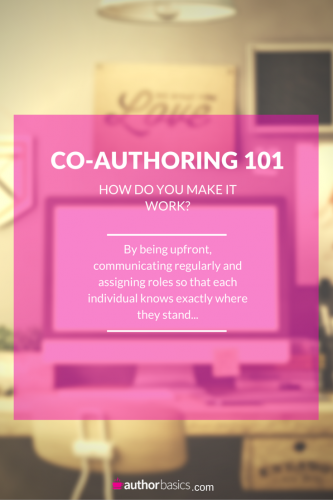After co-authoring three books last year, I can safely say that it works pretty well… but it definitely isn’t without it’s challenges.
As many of you know, Steve and I are in the middle of writing a fiction book together! Not-to-mention running Author Basics, keeping tabs on our own author businesses and you know, keeping bread on the table!
Lately, I’ve been asked more about the technical aspects of co-authoring, with various questions including:
- How do you write a book together? Does someone write the first draft and then you do the second draft? How?
- Who does the outline or comes up with the plot?
- What do you use to write the book in? Surely you can’t both use Scrivener!
- Who is responsible for formatting and uploading to Kindle?
- What about costs associated with the book — what do you do there?
These are definitely the top five questions I’ve been asked since I co-authored those books last year and I wanted to take a moment to let you all know how it actually works and provide some answers to these questions.
Co-Authoring 101
#1: How do you write a book with someone else?
This part of the process really comes down to the individuals writing the books. For the first two books I co-authored last year, Free Your Fear and Better Book Funnels, we each choose a number of chapters that we wanted to write.
This worked well because between the two of us, we had knowledged in specific areas that complemented each other, which is the main reason I choose to write those two books with the people I did.
Keep this in mind when you’re looking at co-authoring, particularly when it comes to non-fiction. Generally speaking, if you are both bringing the same thing to the table, it might not work as well.
Now when it comes to fiction, things are a little different… it’s easier for one person to write the first draft and the second person to go through and make changes in the second draft. This is how Steve and I are writing our YA novel right now. It’s working really well, with Steve updating me daily on where he’s at word count wise plus giving me access to see how the story is developing, although I already have a fair idea of the plot, it’s amazing to see everything else come to life.
If you’re considering co-authoring with someone else, make sure that you work well together by working on a smaller project, like writing a joint blog-post or creating something together. It’ll give you an idea of just how well you might work together on something like a book.
#2: Who creates the outline or plot?
This really depends on what each of you brings to the table. For the first two non-fiction books above, Mike came up with the first initial draft of the outline for Free Your Fear, and then we worked on refining in together.
For Better Book Funnels, I came up with the initial outline draft and then Liz and I worked on refining it together.
For our Author Basics books, Steve and I worked on coming up with an outline together in a Google Doc and then we each picked which book we’d like to take a crack at first draft, then we’d hand over to the other for the second draft.
Each author pairing is going to work differently, so it’s up to you go decide this at the outset.
For our fiction novel, Steve and I jumped on a Google Hangout and spent 4 hours fleshing out the 4-part story structure and coming up with story ideas for the book. By the end of our discussion, we had a solid outline that allowed Steve to hit the ground running in the first draft.
Again, it comes down to each author pairing. The guys over at Realm & Sands do a similar process and pump out a ton of books because of their co-authoring prowess!
#3: What program do you use to write the book in?
 This really comes down to personal preference. For the non-fiction books I wrote with Mike and Liz, we used Google Docs and then I formatted it in Scrivener once we were finished.
This really comes down to personal preference. For the non-fiction books I wrote with Mike and Liz, we used Google Docs and then I formatted it in Scrivener once we were finished.
Steve and I, on the other hand, use Scrivener! We have a shared Dropbox folder that our stories sit in, so while we can’t both be in the same file at the same time, we can both access the files individually.
Scrivener updates in real-time and we make it work by leaving comments and notes throughout the file. We also use the colored revision mode within Scrivener that allows you to see where changes have been made, kinda like the ‘track changes’ in MS Word. This works extremely well for us, and allows each of us to quickly see what’s changed since we were last in the file.
We also have an awesome editor who edits our stuff right inside Scrivener and she also uses the revision mode feature. She has been assigned red 😉
The other awesome thing we do inside Scrivener is color-code each scene or chapter based on where it’s at. So if it’s in first draft, then Steve will color the document in the binder as ‘first draft’ once he’s moved onto the next document. This allows me to know that he’s finished what he’s doing and then I’m good to jump in and start on the second draft part of the process.
I’ll also color mine ‘second draft’ once I’m done and then we’ll both go through a third draft and begin the editing process.
So in short, Scrivener and Google Docs are both viable, avoid using MS Word if you don’t want a nightmare on your hands come combining drafts and formatting time!
#4: Who is responsible for formatting and uploading to publishing platforms?
This really depends on your own author business setup. With Mike and Liz, because I already had an established Amazon KDP and Createspace account, I took care of the uploading to both of those areas.
I also formatted the books in both instances.
When it comes to Steve and I, Steve handles the formatting and uploading process, with some input from me on fonts etc on the formatting side.
This is definitely something you wanna figure out who is going to handle upfront, because it can decide the program you’ll use to write your book in.
Whomever is going to format and upload, doesn’t have to write book descriptions or come up with keywords, that’s over to the other person. Yes you’ll collaborate on every area, but the responsibility of driving each of these areas should always lie with one person so that there’s no double ups and so that shit gets done!
#5: What do you do about costs associated with the book?
When talking about costs, we’re referring to the following:
- Cover design
- Editing
- Marketing
To be honest, this is a fairly easy one to cover. We simply go halfsies! This keeps it fair and unless one person does more than the other, I see no reason why this wouldn’t be the case for most co-authoring setups.
Phew, I know that was a lot to cover and digest, but I hope it gives you a much clearer idea of how co-authoring works. Keep it simple, communicate regularly and be upfront about what the role is of each person and you shouldn’t have any issues!
Are you planning to co-author a book or you have and would like to add your two cents? Leave your thoughts, feedback and suggestions in the comments below!


